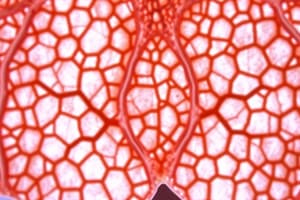Podcast
Questions and Answers
What are the main functions of connective tissue in the body?
What are the main functions of connective tissue in the body?
Support other body components, transmit signals, and maintain homeostasis
Describe the composition of areolar connective tissue.
Describe the composition of areolar connective tissue.
Contains fibroblasts, collagen, elastin, and ground substance
What is the main role of adipose tissue in the body?
What is the main role of adipose tissue in the body?
Stores fat and helps regulate metabolic processes, insulation, energy storage, and cushioning mechanical stresses in joints
Where can areolar connective tissue be found in the body?
Where can areolar connective tissue be found in the body?
What are the four main types of connective tissue mentioned in the text?
What are the four main types of connective tissue mentioned in the text?
What are the two main types of dense connective tissues and what roles do they play in the body?
What are the two main types of dense connective tissues and what roles do they play in the body?
How does collagenous tissue differ from elastic tissue in terms of composition and function?
How does collagenous tissue differ from elastic tissue in terms of composition and function?
What distinguishes cartilage from bone in terms of structure and function within dense connective tissue?
What distinguishes cartilage from bone in terms of structure and function within dense connective tissue?
Describe the composition and function of bone tissue in the context of dense connective tissue.
Describe the composition and function of bone tissue in the context of dense connective tissue.
How do connective tissues contribute to the overall function of the human body, and why is understanding them important?
How do connective tissues contribute to the overall function of the human body, and why is understanding them important?
Flashcards are hidden until you start studying
Study Notes
Tissues: Connecting Our Body's Structures
Tissues are fundamental building blocks of our bodies, forming complex structures based on their specialized composition. One type of tissue that plays a crucial role is connective tissue. In this exploration, we delve deeper into what connective tissues are and their diverse roles within our organism.
Connective tissue is characterized by its ability to support other body components, transmit signals, and maintain homeostasis through various mechanisms. It can be found everywhere from beneath the skin to the framework of bones, blood vessels, and organs. There are four main types of connective tissue: loose connections like areolar and adipose, dense regular such as collagenous and elastic, cartilage, and bone.
Areolar connective tissue serves primarily as a supportive scaffold and houses cells engaged in immune responses. This tissue contains fibroblasts, collagen, elastin, and ground substance, providing flexibility and support. A well-known example of areolar connective tissue lies under the skin, also known as dermis, creating a protective barrier against external threats while allowing it to stretch when needed.
Adipose tissue, another variant of connective tissue, stores fat and helps regulate metabolic processes, insulation, energy storage, and cushioning mechanical stresses in joints. Adipocytes, or fat cells, are filled with lipid droplets and produce hormones like leptin and adiponectin, which play essential roles in appetite regulation and inflammation control. Given the shift towards obesity worldwide, understanding adipose tissue has become increasingly important in medicine and health promotion efforts.
Dense connective tissues, including collagenous and elastic, supply strength and stability to different body parts. Collagenous tissue, made up mainly of thick bundles of collagen fibers, forms tendons and ligaments connecting muscles to bones and stabilizing joints, respectively. Elastic connective tissue, in contrast, possesses more flexible elements like elastin, contributing to the resiliency and extensibility of structures such as arterial walls, lungs, and vocal cords.
The last two types — cartilage and bone — both belong to dense connective tissue, although they differ significantly. Cartilage provides structural integrity yet retains flexibility; examples include articular cartilage covering the ends of bones at joints and hyaline cartilage in nose and trachea. Bone tissue, composed of calcium phosphate crystals called hydroxyapatite embedded within organic proteins, exhibits rigidity and resistance to deformation due to compression forces.
In summary, connective tissues provide structure, support, protection, and movement in our bodies. They consist of diverse cellular components and extracellular matrices, performing numerous critical biological functions. Understanding these basic concepts will help us appreciate the intricate dance between specializations, cooperation, and coordination occurring across all levels of human physiology and pathophysiology.
Studying That Suits You
Use AI to generate personalized quizzes and flashcards to suit your learning preferences.




